Why Read This Article?
Finish Nailer Repair - Replacing the Driver Guide (Ridgid Part # 79004001022)
Article Breakdown
Finish Nailer Repair - Replacing the Driver Guide (Ridgid Part # 79004001022)
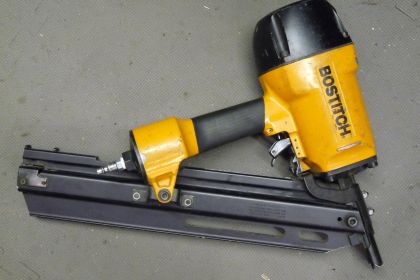
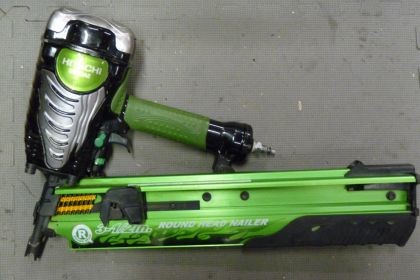
Air nailers break down over time from normal wear. Performance problems can also be caused by incorrect parts, incorrect assembly, misuse, incorrect air pressure and a number of other things. There is quite a checklist to go through if a nailer starts leaking air or if the driver does not retract (for example), but diagnosing can be split up and organized so that the cause is quickly discovered.
This article addresses the most common air nailer problems one symptom at a time.
Unfortunately, most air nailer problems require a part or two to be replaced in order to fix the problem, but the bright side is the most commonly replaced parts are inexpensive. The best way to avoid air nailer problems is to prevent them as much as possible.
Air Nailer Pre-Diagnosis
This section is really about performing air nailer maintenance, checking that the correct air pressure is being used, that the nailer's parts match and are installed correctly, and that the most obvious causes of air leaks are prevented.
These are things that should be "givens" when it comes to using an air nailer. If an air nailer user is confident that these checks and maintenance issues are always in order, then half of the common causes of air nailer problems are already eliminated.
Here's the thing: say, for example, that a nailer's driver starts retracting slowly after a couple of months. As will be discussed below, that could be caused by worn O-rings, mis-sized O-rings, and other parts issues. But, the same exact behavior in the nailer can be caused by something as simple as low air pressure supply.
Since that's the case, the best way to know if there's a part replacement in the near future is to just eliminate the simple issues ahead of times. Most of the major nailer symptoms follow this pattern, that one symptom can either be cause by something simple and preventable, or by a number of more complicated issues.
In that way, these practices of maintaining the nailer and checking its set-up become a set of assumptions that "pre-diagnose" many problems, by eliminating them through prevention.
Later in this article when symptoms are addressed individually maintenance and set-up causes will not be discussed, because it will be assumed that the guidelines in this section have already been addressed, rechecked, and followed.
Correct Air Pressure
Know and check the nailer's operating pressure, which should be found in the owner's manual. If the manual is not available, they are usually available to view online on the nailer manufacturer's website. Most nailers are ran between about 100 psi and 120 psi.
Low air pressure can cause these symptoms:
- the gun doesn't work at all.
- driver won't retract after firing.
- driver retracts slowly.
- poorly sunk nails.
- splitting wood.
- air leaks.
- broken parts or casing.
- heavy wear.
Lubrication Some nailers are oil-less, but most use oil, have to stay well lubricated, and should be lubricated after each use. A poorly oiled air nailer can cause damage to parts, and pretty much every symptom in the book, including air leaks, driver jams, pusher guide malfunctions, and nail loading errors. A very dry gun will not fire at all. Too much oil will become a messy, obvious problem. Nailers only need a few drops each day to prevent many malfunctions. Nailers require special oil used for air tools called Air Tool Oil.
[Back to top]
Correct Parts, Tool Assembly, and Nails
Almost any nailer symptom can be caused by installing an incompatible part or by reassembling the tool incorrectly. So, if a nailer starts leaking air or jamming up, say, after an O-ring replacement, an incorrect part or assembly mistake should be the first suspects. Most O-ring kits, valve kits, and other parts come with instructions for assembly. Some even have handy color codes that help keep all the rings straight. Be absolutely certain that the correct part is being installed into the nailer before beginning the repair. Any mistake during reassembly can cause leaks and other break-downs. It is a common mistake to reinstall some of the circular parts backwards. Because the tool is a pressured system, everything must be tightened very well, which is another common oversight. In general, and depending on the brand and model of the nailer, air nailer repairs can get a little tricky sometimes, so repairs should only be performed when the repairman is very confident. Pushers/guides can be especially hard to reinstall after disassembly. Nails type is an issue all its own. Sometimes nail jams, misfires, and guide jams are caused by use of the wrong kind of nails. This is especially true of some Hitachi models. Before looking into more complicated causes, make sure that nail type guidelines are followed as found in the user manual. [Back to top] Dirt and/or Water in the Nailer Dirt and/or water in the nailer can also make the tool act up in various ways, from the driver, the magazine, to not working at all. Dirt will bind up the sliding parts, like the nail feed area, the nose safety, and the driver. A dirty nailer should be cleaned thoroughly, otherwise all that dirt will wear moving parts down in a hurry. The magazine and feed area can be sprayed out with an air hose (make very sure that the air is dry). If dirt has gotten all the way up inside the nailer, it will have to be disassembled and cleaned. Dirty nailers should be taken to a professional shop for disassembly and service if the user has any doubts. 99% of the time, the only way that water gets into the nailer is through the air supply. Water builds up inside of air compressors from the humidity in the air. Air compressors have a drain valve on their tanks for removing water from their systems. Air compressors should be drained of water before each use. Water getting into the nailer will cause the same problems that dirt will, and is especially bad for oiled guns. Nail guns should be allowed to completely dry if water has gotten into them. Sometimes this means disassembling the gun so that the water can dry up faster. After drying, it's best to re-lubricate the tool.
[Back to top] Simple Air Leaks By "simple," we mean that the air leak is easily resolved by obvious methods that usually don't (except with cracked cases) require parts replacement. For example, air coming out the bottom of the gun because the air hose is attached too loosely is an obvious air leak: tighten the hose fitting. But air coming out the bottom of the tool because of a worn valve or O-ring is a more complicated leak. The best way to know if the problem is simple or complicated is to eliminate the simple possibilities, again, through prevention. Simple air leaks can be caused by:
- loose air connections.
- cracks in the tool casing.
- pressure too high.
- loose fittings around the tool.
- dirt.
- poor lubrication.
Sometimes the only reason air is leaking from the nailer is because a seal, O-ring, or valve has moved out of place and become "unseated." This cause is difficult to diagnose, especially without all that pre-diagnosing. If you suspect that parts of the tool need to be reseated, try one of the two methods below.
Steps to "seat" air nailer seals:
1. Dry fire the nailer.
2. Give it a good, solid bump on the back of the tool to reposition those valves and O-rings (This is especially true for some Hitachi models.)
This works especially well for some Bostich model nailers. Air leaking out the back can often be solved be re-seating components.
If the diagnosis comes down to a close inspection of parts (for any model), look for wear and damage like dry/cracked O-rings, worn valves, bent and/or kinked springs, look closely for little pin-sized holes in O-rings and seals, and check that no part of tool is bent or warped.
Most of the time, when a part is causing an air leak, it's an O-ring, which is good since O-rings, and O-ring kits are inexpensive. It's a good idea to have a kit around for fast repairs if they are available.
Air Leaks Out Nose
Like other leaks, air coming out the nose of the gun may just be a sign that seals need to be re-seated, so try giving it a bump and dry firing it first.
If that doesn't work, then the cause of air coming out the nose of the gun is probably because of one of two things:
1. The nailer's nose piece is worn, damaged, and needs replacement.
2. An O-ring, or other part somewhere in the forward part of the gun is worn or damaged and must be replaced. Disassemble the nailer and inspect its parts for damage/wear or take it to a shop.
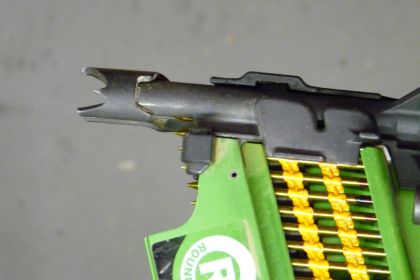
Air Leaks Out Vents Try "seating" seals and valves first with a good bump. If that doesn't work, then the cause is most likely a damaged or worn part, like an O-ring or valve. Disassemble the nailer and inspect it parts for damage/wear, or take it to a shop. Air Leaks Out Back This is a good sign that seals need to be reseated with dry firing or bumping the gun, but it is also possible that air is leaking out the back of the tool because of a broken part. If attempts to reseat the seals fail, the tool will have to be disassembled and inspected for wear or damage to parts. Air Leaks Out Trigger Good news and bad new with this one. The good news is that when air leaks out the trigger of a nailer, it's easy to diagnose. This is almost always caused by a worn trigger valve. The bad news is that trigger valves are never sold separately, so the entire trigger assembly must be replaced. It's possible that air could leak out the trigger because of damage to some other part, but very unlikely.
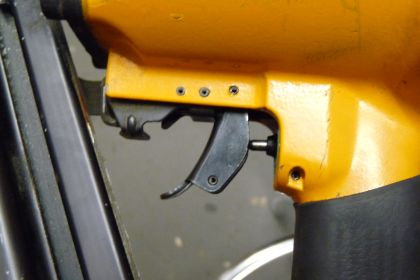
[Back to top]
Driver Does Not Retract or Retracts Slowly
Again, an incorrectly retracting driver can be caused by some of the issues covered in Pre-Diagnosis (and is most-likely caused by those problems: dirt, lack of lubrication, etc.), so it's best to go through that checklist first.
However, like air leak problems, driver issues can be caused by reduced internal pressure from worn or damaged parts.
Take a look at the parts around the driver and piston cylinder. Seals and O-rings are the most likely suspects. Damaged O-rings in this area are likely to have little holes in them.
Take the nailer to a shop when there are any doubts about disassembly, parts installation, or reassembly. If an O-ring kit is available for the air nailer, it's a good idea to keep one around for this reason. If not, O-rings will have to be matched and purchased separately.
[Back to top]
Pusher/Guide Not Working Correctly
Dirt and other issues covered in Pre-Diagnosis can make the pusher run slowly or not at all.
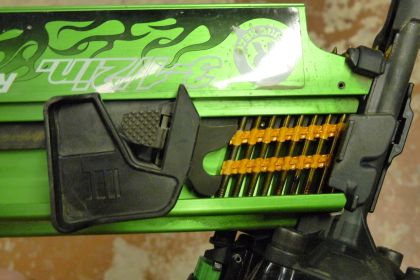
Other causes:
- magazine is bent.
- loader springs bent, worn, or kinked.
- guide channel is too narrow.
- guide is broken.
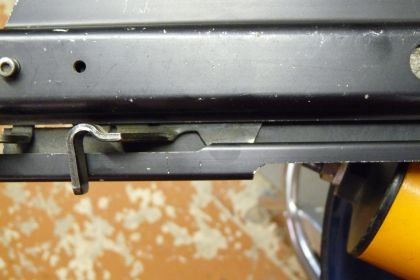
If the guide is broken or heavily worn, it will have to be replaced.
[Back to top]
Double Fire
Double fire is usually caused by one of three things:
1. The nailer is not being held down with enough pressure when the nailer is fired.
2. The trigger valve is leaking and not releasing fast enough for a single shot.
3. The pressure fire feature on the nose of the gun (if applicable) is inoperative. If adding pressure does not help, then it is most likely the trigger, which will have to be replaced. For guns that use a press-and-fire system, the spring in the nose of the gun may be worn, causing the ejection of an additional nail. [Back to top] Conclusion The issues and symptoms discussed in this article are very common to air nailer use. Even with the right use, maintenance, and prevention, air nailers will eventually need repairs and replacement parts, like most other power tools. The great thing about a good nailer is that it can last a lifetime with the minimal expense and hassle with the right know-how. To get started finding a nailer part for a replacement repair, visit our Nailer Parts page to find your air nailer by brand and model. Or, type the nailer's model number in the search field at the top of this page. Good luck with your repairs! [Back to top] What we're about.


















































